热门标签
当前位置: article > 正文
2024版本idea集成SpringBoot + Ai 手写一个chatgpt 【推荐】_idea2024的ai怎么用
作者:繁依Fanyi0 | 2024-06-04 01:13:02
赞
踩
idea2024的ai怎么用
题目:SpringBoot + OpenAi 代码获取
在这里获取key和url:获取免费key
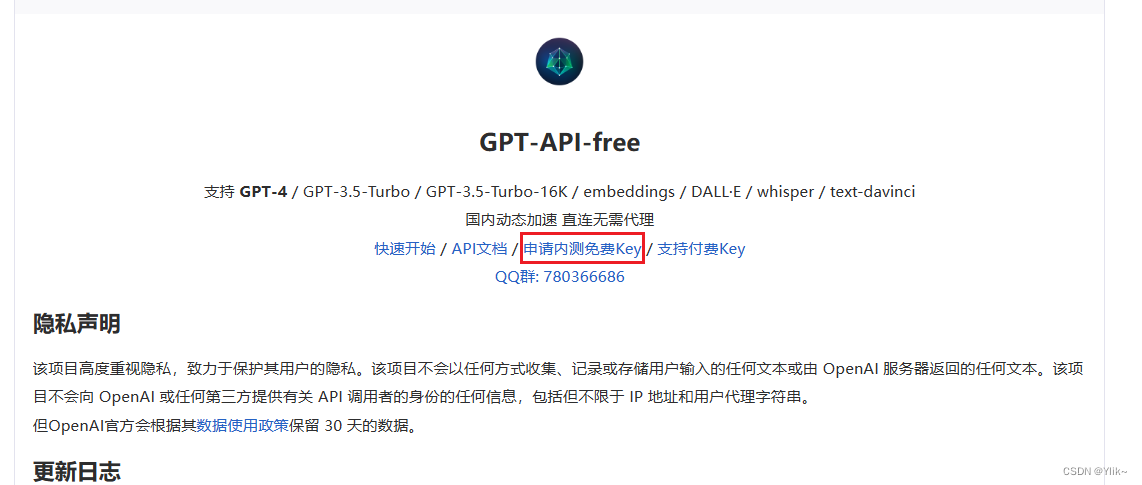
base-url为这两个:


话不多说直接来!
一、简介
Spring AI 是 AI 工程的应用框架。其目标是将 Spring 生态系统设计原则(如可移植性和模块化设计)应用于 AI,并推广使用 POJO 作为 AI 领域应用程序的构建块。
跨 AI 提供商的可移植 API 支持,适用于聊天、文本到图像和嵌入模型。支持同步和流 API 选项。还支持下拉以访问特定于模型的功能
二、Ai聊天程序代码
1、 创建项目工程
- 在父工程下面创建新的模块
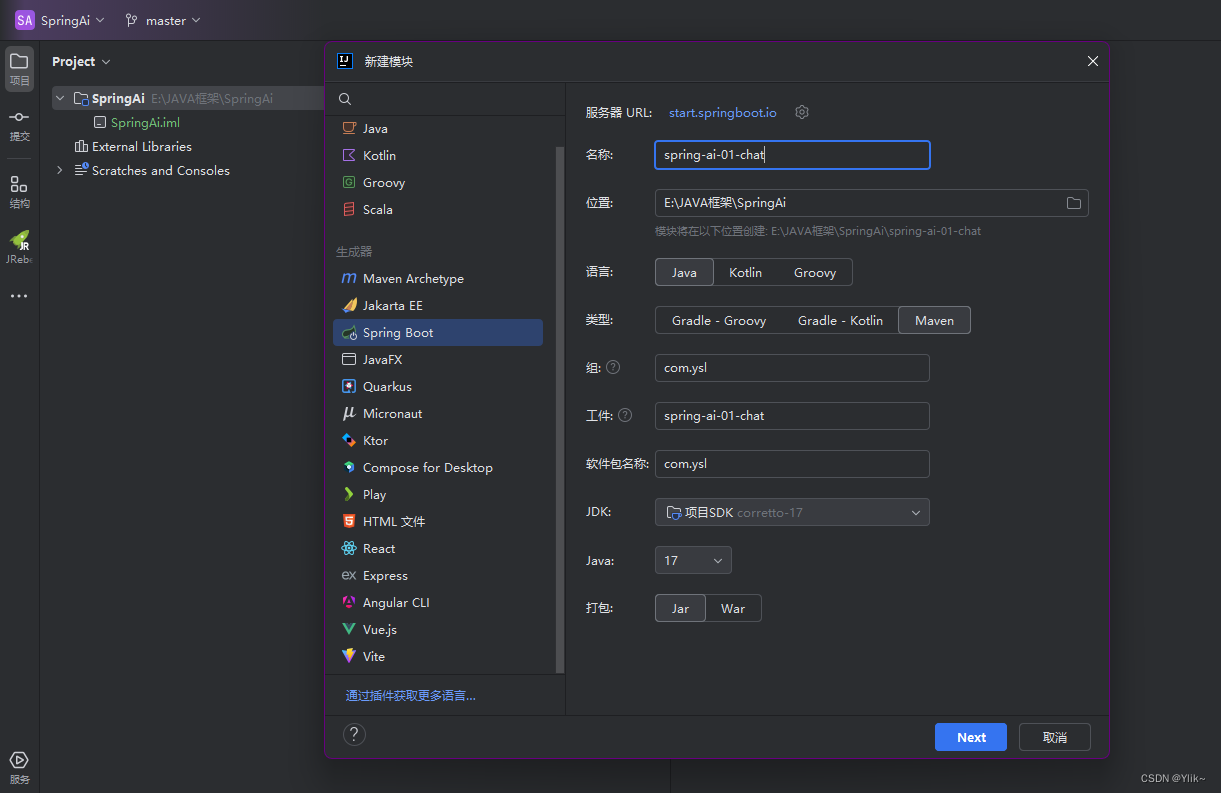
- 勾选上依赖然后创建

- 具体的依赖如下
<?xml version="1.0" encoding="UTF-8"?> <project xmlns="http://maven.apache.org/POM/4.0.0" xmlns:xsi="http://www.w3.org/2001/XMLSchema-instance" xsi:schemaLocation="http://maven.apache.org/POM/4.0.0 https://maven.apache.org/xsd/maven-4.0.0.xsd"> <modelVersion>4.0.0</modelVersion> <parent> <groupId>org.springframework.boot</groupId> <artifactId>spring-boot-starter-parent</artifactId> <version>3.2.4</version> <relativePath/> <!-- lookup parent from repository --> </parent> <!-- Generated by https://start.springboot.io --> <!-- 优质的 spring/boot/data/security/cloud 框架中文文档尽在 => https://springdoc.cn --> <groupId>com.ysl</groupId> <artifactId>SpringAi</artifactId> <version>0.0.1-SNAPSHOT</version> <packaging>pom</packaging> <name>SpringAi</name> <description>SpringAi</description> <modules> <module>spring-ai-01-chat</module> </modules> <properties> <java.version>17</java.version> <!-- 快照版本--> <spring-ai.version>1.0.0-SNAPSHOT</spring-ai.version> </properties> <dependencies> <dependency> <groupId>org.springframework.boot</groupId> <artifactId>spring-boot-starter-web</artifactId> </dependency> <dependency> <groupId>org.springframework.ai</groupId> <artifactId>spring-ai-openai-spring-boot-starter</artifactId> </dependency> <dependency> <groupId>org.springframework.boot</groupId> <artifactId>spring-boot-devtools</artifactId> <scope>runtime</scope> <optional>true</optional> </dependency> <dependency> <groupId>org.projectlombok</groupId> <artifactId>lombok</artifactId> <optional>true</optional> </dependency> <dependency> <groupId>org.springframework.boot</groupId> <artifactId>spring-boot-starter-test</artifactId> <scope>test</scope> </dependency> </dependencies> <!-- 相当于继承一个父项目:spring-ai-bom--> <dependencyManagement> <dependencies> <dependency> <groupId>org.springframework.ai</groupId> <artifactId>spring-ai-bom</artifactId> <version>${spring-ai.version}</version> <type>pom</type> <scope>import</scope> </dependency> </dependencies> </dependencyManagement> <build> <plugins> <plugin> <groupId>org.springframework.boot</groupId> <artifactId>spring-boot-maven-plugin</artifactId> <configuration> <image> <builder>paketobuildpacks/builder-jammy-base:latest</builder> </image> <excludes> <exclude> <groupId>org.projectlombok</groupId> <artifactId>lombok</artifactId> </exclude> </excludes> </configuration> </plugin> </plugins> </build> <!--~配置本项目的仓库:因maven中心仓库还设有更新spring ai的jar包--> <repositories> <repository> <!-- 里程碑版本releases的仓库,改成快照版本的snapshot--> <id>spring-snapshot</id> <name>Spring Snapshots</name> <url>https://repo.spring.io/snapshot</url> <releases> <enabled>false</enabled> </releases> </repository> </repositories> </project>
- 1
- 2
- 3
- 4
- 5
- 6
- 7
- 8
- 9
- 10
- 11
- 12
- 13
- 14
- 15
- 16
- 17
- 18
- 19
- 20
- 21
- 22
- 23
- 24
- 25
- 26
- 27
- 28
- 29
- 30
- 31
- 32
- 33
- 34
- 35
- 36
- 37
- 38
- 39
- 40
- 41
- 42
- 43
- 44
- 45
- 46
- 47
- 48
- 49
- 50
- 51
- 52
- 53
- 54
- 55
- 56
- 57
- 58
- 59
- 60
- 61
- 62
- 63
- 64
- 65
- 66
- 67
- 68
- 69
- 70
- 71
- 72
- 73
- 74
- 75
- 76
- 77
- 78
- 79
- 80
- 81
- 82
- 83
- 84
- 85
- 86
- 87
- 88
- 89
- 90
- 91
- 92
- 93
- 94
- 95
- 96
- 97
- 98
- 99
- 100
- 101
- 102
- 103
- 编写yml配置

- openai有自动配置类OpenAiAutoConfiguration

其中有聊天客户端,图片客户端…等(看下面源码)
//聊天客户端 @Bean @ConditionalOnMissingBean @ConditionalOnProperty(prefix = OpenAiChatProperties.CONFIG_PREFIX, name = "enabled", havingValue = "true", matchIfMissing = true) public OpenAiChatClient openAiChatClient(OpenAiConnectionProperties commonProperties, OpenAiChatProperties chatProperties, RestClient.Builder restClientBuilder, List<FunctionCallback> toolFunctionCallbacks, FunctionCallbackContext functionCallbackContext, RetryTemplate retryTemplate, ResponseErrorHandler responseErrorHandler) { var openAiApi = openAiApi(chatProperties.getBaseUrl(), commonProperties.getBaseUrl(), chatProperties.getApiKey(), commonProperties.getApiKey(), restClientBuilder, responseErrorHandler); if (!CollectionUtils.isEmpty(toolFunctionCallbacks)) { chatProperties.getOptions().getFunctionCallbacks().addAll(toolFunctionCallbacks); } return new OpenAiChatClient(openAiApi, chatProperties.getOptions(), functionCallbackContext, retryTemplate); }
- 1
- 2
- 3
- 4
- 5
- 6
- 7
- 8
- 9
- 10
- 11
- 12
- 13
- 14
- 15
- 16
- 17
- 18
- 19
//图片客户端 @Bean @ConditionalOnMissingBean @ConditionalOnProperty(prefix = OpenAiImageProperties.CONFIG_PREFIX, name = "enabled", havingValue = "true", matchIfMissing = true) public OpenAiImageClient openAiImageClient(OpenAiConnectionProperties commonProperties, OpenAiImageProperties imageProperties, RestClient.Builder restClientBuilder, RetryTemplate retryTemplate, ResponseErrorHandler responseErrorHandler) { String apiKey = StringUtils.hasText(imageProperties.getApiKey()) ? imageProperties.getApiKey() : commonProperties.getApiKey(); String baseUrl = StringUtils.hasText(imageProperties.getBaseUrl()) ? imageProperties.getBaseUrl() : commonProperties.getBaseUrl(); Assert.hasText(apiKey, "OpenAI API key must be set"); Assert.hasText(baseUrl, "OpenAI base URL must be set"); var openAiImageApi = new OpenAiImageApi(baseUrl, apiKey, restClientBuilder, responseErrorHandler); return new OpenAiImageClient(openAiImageApi, imageProperties.getOptions(), retryTemplate); }
- 1
- 2
- 3
- 4
- 5
- 6
- 7
- 8
- 9
- 10
- 11
- 12
- 13
- 14
- 15
- 16
- 17
- 18
- 19
- 20
- 21
- 22
二、一个简单的示例
1、直接写一个Controller层就可以
package com.ysl.controller; import jakarta.annotation.Resource; import org.springframework.ai.chat.ChatResponse; import org.springframework.ai.chat.prompt.Prompt; import org.springframework.ai.openai.OpenAiChatClient; import org.springframework.ai.openai.OpenAiChatOptions; import org.springframework.web.bind.annotation.RequestMapping; import org.springframework.web.bind.annotation.RequestParam; import org.springframework.web.bind.annotation.RestController; import reactor.core.publisher.Flux; /** * @Author Ysl * @Date 2024/5/11 * @name SpringAi **/ @RestController public class ChatController { /** * OpenAi自动装配,可以直接注入使用 */ @Resource private OpenAiChatClient openAiChatClient; /** * 调用OpenAi的接口,call方法为同步的api * @param msg 你要问的问题 * @return */ @RequestMapping ("/ai/chat") public String chat(@RequestParam("msg") String msg) { String call = openAiChatClient.call(msg); return call; } /** * 调用OpenAi的接口 * @param msg 你要问的问题 * @return Object--json对象 */ @RequestMapping ("/ai/chat1") public Object chat1(@RequestParam("msg") String msg) { ChatResponse response = openAiChatClient.call(new Prompt(msg)); return response; // return response.getResult().getOutput().getContent();//只拿到内容 } /** * 调用OpenAi的接口 * @param msg 你要问的问题 * @return */ @RequestMapping ("/ai/chat3") public String chat3(@RequestParam("msg") String msg) { //可选参数在yml配置,同时在代码中也配置,那么会以代码为准 ChatResponse response = openAiChatClient.call(new Prompt(msg, OpenAiChatOptions.builder() // .withModel("gpt-4")//使用的模型 .withTemperature(0.3F)//温度越高回答越慢,温度越低回答越快 .build())); return response.getResult().getOutput().getContent(); } /** * 调用OpenAi的接口 stream是流式的api * @param msg 你要问的问题 * @return */ @RequestMapping ("/ai/chat4") public Object chat4(@RequestParam("msg") String msg) { //可选参数在yml配置,同时在代码中也配置,那么会以代码为准 Flux<ChatResponse> flux = openAiChatClient.stream(new Prompt(msg, OpenAiChatOptions.builder() // .withModel("gpt-3.5")//使用的模型 .withTemperature(0.3F)//温度越高回答越慢,温度越低回答越快 .build())); flux.toStream().forEach(chatResponse ->{ System.out.println(chatResponse.getResult().getOutput().getContent()); }); return flux.collectList();//数据的序列 } }
- 1
- 2
- 3
- 4
- 5
- 6
- 7
- 8
- 9
- 10
- 11
- 12
- 13
- 14
- 15
- 16
- 17
- 18
- 19
- 20
- 21
- 22
- 23
- 24
- 25
- 26
- 27
- 28
- 29
- 30
- 31
- 32
- 33
- 34
- 35
- 36
- 37
- 38
- 39
- 40
- 41
- 42
- 43
- 44
- 45
- 46
- 47
- 48
- 49
- 50
- 51
- 52
- 53
- 54
- 55
- 56
- 57
- 58
- 59
- 60
- 61
- 62
- 63
- 64
- 65
- 66
- 67
- 68
- 69
- 70
- 71
- 72
- 73
- 74
- 75
- 76
- 77
- 78
- 79
- 80
- 81
- 82
2、直接在浏览器访问
- http://localhost:8080/ai/chat?msg=24年经济形势

- http://localhost:8080/ai/chat1?msg=24年经济形势
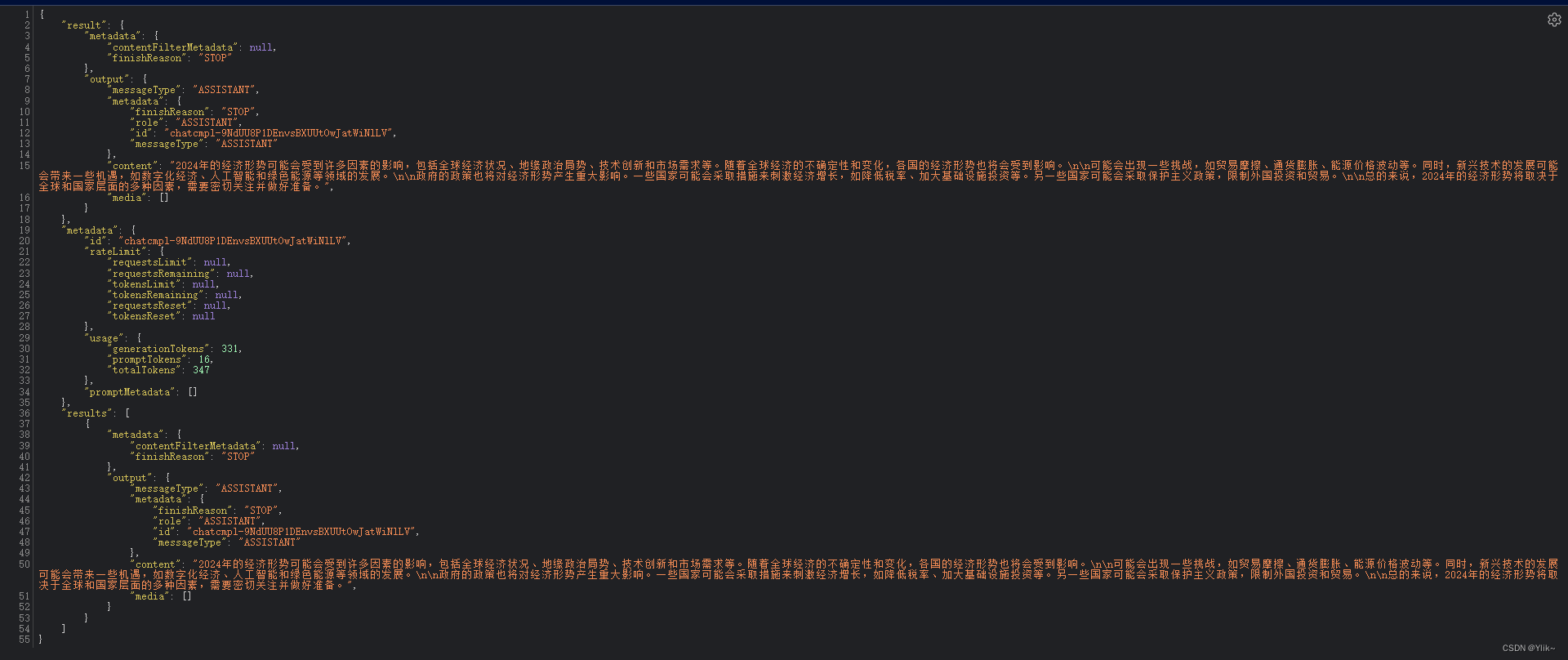
- http://localhost:8080/ai/chat3?msg=java怎么学

OpenAi聊天客户端就写到这里,接下来是图片客户端。
三、Ai画图程序代码
首先需要确保你的key支持绘图可以使用DALL·E 模型
1、创建一个子项目(pom文件的依赖和第一个项目一样即可)
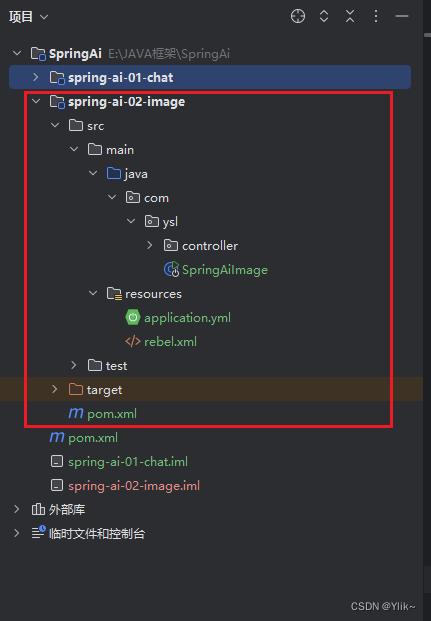
2、编写yml配置文件

3、编写controller层
import jakarta.annotation.Resource; import org.springframework.ai.image.ImagePrompt; import org.springframework.ai.image.ImageResponse; import org.springframework.ai.openai.OpenAiImageClient; import org.springframework.ai.openai.OpenAiImageOptions; import org.springframework.web.bind.annotation.RequestMapping; import org.springframework.web.bind.annotation.RequestParam; import org.springframework.web.bind.annotation.RestController; /** * @Author Ysl * @Date 2024/5/12 * @name SpringAi **/ @RestController public class ImageController { @Resource private OpenAiImageClient openAiImageClient; @RequestMapping("/ai/image") public Object image(@RequestParam("msg") String msg) { ImageResponse imageResponse = openAiImageClient.call(new ImagePrompt(msg)); // 对图片进行业务处理(拿到图片的链接) String url = imageResponse.getResult().getOutput().getUrl(); return imageResponse.getResult().getOutput(); } @RequestMapping("/ai/image2") public Object image2(@RequestParam("msg") String msg) { //第二个参数是传递图片的参数,同样可在yml里配置 ImageResponse imageResponse = openAiImageClient.call(new ImagePrompt(msg, OpenAiImageOptions.builder() .withQuality("hd")//高清 .withN(1)//生成1张,可填数字1-10 .withHeight(1024)//高度 .withWidth(1024)//宽度 .build() )); // 对图片进行业务处理(拿到图片的链接) String url = imageResponse.getResult().getOutput().getUrl(); return imageResponse.getResult().getOutput(); } }
- 1
- 2
- 3
- 4
- 5
- 6
- 7
- 8
- 9
- 10
- 11
- 12
- 13
- 14
- 15
- 16
- 17
- 18
- 19
- 20
- 21
- 22
- 23
- 24
- 25
- 26
- 27
- 28
- 29
- 30
- 31
- 32
- 33
- 34
- 35
- 36
- 37
- 38
- 39
- 40
- 41
- 42
- 43
- 44
- 45
3、访问链接
- http://localhost:8080/ai/image?msg=画一只蝴蝶
- http://localhost:8080/ai/image2?msg=画一只蝴蝶
4、结果:

打开链接

Ai画图就讲到这里,下面是音频翻译
四、Ai音频翻译代码
首先确保你的key可以使用whisper 模型
1、创建子项目编写配置文件
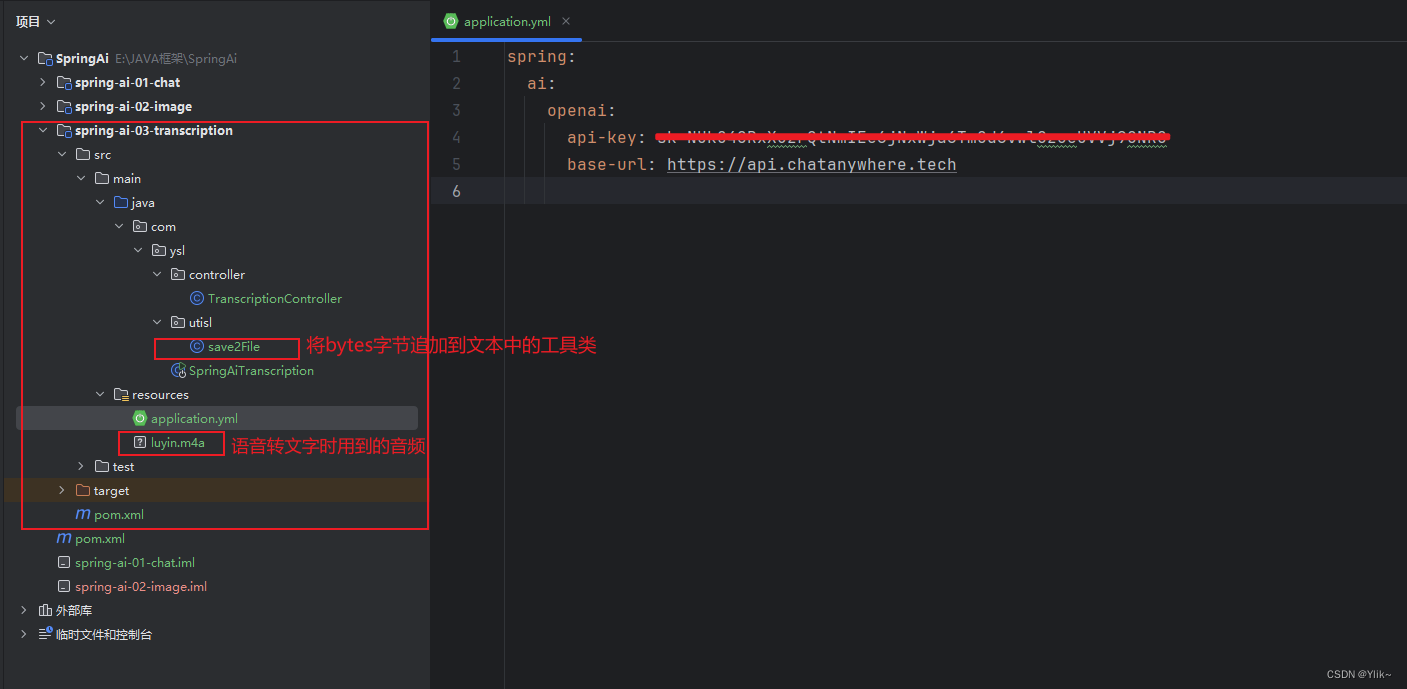
2、用到的工具类:将bytes[ ]字节数组写入新建的文件中
import java.io.*; /** * @Author Ysl * @Date 2024/5/12 * @name SpringAi **/ public class save2File { /** * 方法功能:将字节数组写入到新建文件中。 * @param fname * @param msg * @return boolean * */ public static boolean save2File(String fname, byte[] msg){ OutputStream fos = null; try{ File file = new File(fname); File parent = file.getParentFile(); boolean bool; if ((!parent.exists()) && (!parent.mkdirs())) { return false; } fos = new FileOutputStream(file); fos.write(msg); fos.flush(); return true; } catch (FileNotFoundException e) { return false; }catch (IOException e){ File parent; return false; } finally{ if (fos != null) { try{ fos.close(); }catch (IOException e) {} } } } }
- 1
- 2
- 3
- 4
- 5
- 6
- 7
- 8
- 9
- 10
- 11
- 12
- 13
- 14
- 15
- 16
- 17
- 18
- 19
- 20
- 21
- 22
- 23
- 24
- 25
- 26
- 27
- 28
- 29
- 30
- 31
- 32
- 33
- 34
- 35
- 36
- 37
- 38
- 39
- 40
- 41
- 42
- 43
2、编写controller层
import jakarta.annotation.Resource; import org.springframework.ai.openai.OpenAiAudioSpeechClient; import org.springframework.ai.openai.OpenAiAudioTranscriptionClient; import org.springframework.core.io.ClassPathResource; import org.springframework.web.bind.annotation.RequestMapping; import org.springframework.web.bind.annotation.RestController; import static com.ysl.utisl.save2File.save2File; /** * @Author Ysl * @Date 2024/5/12 * @name SpringAi **/ @RestController public class TranscriptionController { //将音频转文字时使用 @Resource private OpenAiAudioTranscriptionClient transcriptionClient; //将文字转语音时使用 @Resource private OpenAiAudioSpeechClient speechClient; /** * 将音频转文字 * @return */ @RequestMapping("/ai/transcription") public Object transcription() { //读取的是磁盘的路径 //FileSystemResource audioFile = new FileSystemResource("C:\\Users\\DELL\\Desktop\\luyin.m4a"); //读取的是classpath静态资源下的文件 ClassPathResource audioFile = new ClassPathResource("luyin.m4a"); String call = transcriptionClient.call(audioFile); System.out.println(call); return call; } /** * 将文字转音频 * @return */ @RequestMapping("/ai/tts") public Object tts() { String text = "Spring AI 是 AI 工程的应用框架。其目标是将 Spring 生态系统设计原则(如可移植性和模块化设计)应用于 AI,并推广使用 POJO 作为 AI 领域应用程序的构建块。 跨 AI 提供商的可移植 API 支持,适用于聊天、文本到图像和嵌入模型。支持同步和流 API 选项。还支持下拉以访问特定于模型的功能"; byte[] bytes = speechClient.call(text); save2File("C:\\Users\\DELL\\Desktop\\test.mp3",bytes); return "OK"; } }
- 1
- 2
- 3
- 4
- 5
- 6
- 7
- 8
- 9
- 10
- 11
- 12
- 13
- 14
- 15
- 16
- 17
- 18
- 19
- 20
- 21
- 22
- 23
- 24
- 25
- 26
- 27
- 28
- 29
- 30
- 31
- 32
- 33
- 34
- 35
- 36
- 37
- 38
- 39
- 40
- 41
- 42
- 43
- 44
- 45
- 46
- 47
- 48
- 49
- 50
3、访问链接
- 1、 http://localhost:8080/ai/transcription
- 将音频中的话转化为文字显示在页面中

- 2、 http://localhost:8080/ai/tts
- 将text中的文字转为语音后储存在路径C:\Users\DELL\Desktop\test.mp3
- 打开mp3文件即可听到代码中text文本中的内容

声明:本文内容由网友自发贡献,不代表【wpsshop博客】立场,版权归原作者所有,本站不承担相应法律责任。如您发现有侵权的内容,请联系我们。转载请注明出处:https://www.wpsshop.cn/w/繁依Fanyi0/article/detail/669743
推荐阅读

